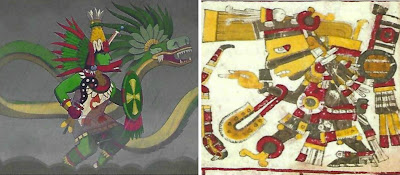Gods and Heroes: Mythology Around the World
written and illustrated by Korwin Briggs
Workman Publishing, 2018, 304 pages
If you are looking for a good, all-around introductory book about the world's most popular gods and heroes for a middle grader, look no further that this comprehensive book.Altogether, there are 75 entries representing 23 cultures, and not only are gods, goddesses, and heroes included, but so mythological creatures and underworlds. Each entry give the tradition name of the character, their home and other names they may be known by. Readers will also learn some fun facts and other interesting tidbits from the world of mythology. Author Briggs is a cartoonist and so each entry has whimsical, colorful illustrations that never manage to loose important characteristics.
One of my young readers borrowed my copy of this book and loved it. And with more and more novels being written that incorporating different cultural myths into their storylines, this can also serve as a help reference book.
For example, did you know that...?
In Slavic and Russian folklore, every home has a spirit called a domovoi that usually takes the form of a tiny, hairy old man;
Athena won a contest to become patron god of Athens by creating the best new invention: the olive tree;
Cú Chulainn, the greatest Celtic hero, has three birthdays;
The Aboriginal Rainbow Snake is one of the world's oldest mythological creatures;
Apsaras, Buddhist and Hindu spirits of clouds and water, take the form of gorgeous, well-dressed women who dance with the utmost grace and precision.
I have to confess that I did not know any of these things, but young readers will discover even more fascinating facts and histories like these in Gods and Heroes.
So, let's meet the Author/Illustrator Korwin Briggs in Five Questions and see what he has to say:
Who is your favorite mythological character featured in the book?
I love the Coyote stories from the American Southwest. I'd like to tell you it's because of the metaphors and symbolism or the broader importance of trickster figures in various world mythologies. But when you've spent month after month reading serious stories about serious gods, it's nice to read about Coyote getting smooshed by a sentient boulder.
Did you have a favorite thing to draw in the book?
Definitely the book's two Aztec/Mayan gods, Quetzalcoatl and Tezcatlipoca. For every drawing, I had a pile of reference images in front of me, including old paintings/engravings/etc. of the god and its culture and a book or two on historical clothing and fashion. In some cases, like Chinese or Greek myths, I had plenty to work with. In others, like the Slavic god Perun, I had to do my best with a few old carvings and some third-hand descriptions.But Quetzalcoatl and Tezcatlipoca were in this neat middle ground where there are good, detailed images, but not many, and they're so dense and stylized. I spent a whole day, totally fascinated, poring over pictures and learning about clothes and costumes that I didn't even know existed.
 |
| L. Quetzalcoatl from Gods and Heroes; R. Tezcatlipoca from the Codex Borgia |
I kept a running tally from the beginning of how many I had of each culture and gender because I wanted the list to be as diverse as possible. If a god/goddess/hero/creature was especially important culturally, or had especially neat and detailed stories, or just let me talk about something interesting (like how Mithra-worship traveled from India to England), I included it.
Do you have any favorites that you couldn't include?
Tons. I could only fit so many articles into 300 pages, and some didn't make the cut. Hermes, the Greek messenger god, is the one I was most sad to miss. He's fantastic and his stories are hilarious, but at that point I already had ten other Greek entries, and something had to give. There were also lots of interesting characters who couldn't quite support a full entry - Incan gods with statues but no remaining stories, or Celtic gods for whom all we have are names and Julius Caesar's assurance that they were really just Roman gods in disguise.
 |
| Medieval monks discuss Loki |
Seriously, though, what's the deal with Loki?
Short answer: No one's sure.
Longer answer: The main problem is a lack of sources. Most of what we know about Norse mythology actually comes from one medieval Icelander named Snorri Sturluson, who was writing more than a century after Christianity had mostly displaced the old Norse religion, and the rest comes from a small assortment of poems and sagas, and trinkets found in Viking burial sites. Some people argue that Loki performed the same role as trickster gods all over the world, acting as chaotic wrench in the gears. There's a theory that the medieval Christians emphasized his negative qualities in the hopes of making paganism look bad. There's also a theory that long, long ago, Loki was less of a trickster and more of a world-destroying giant, and that the later stories that cast him as a prankster are actually an improvement. I don't know which, if any, are true, but they all see to agree that he's a jerk.
Gods and Heroes: Mythology Around the World is a fun, informative book for anyone interested in mythology.
Be sure to visit these stops on the Blog Tour:
The Book Nut
YAYOMG
Flavia the Bibliophile
The One and Only Marfalfa
Bibliophile
Be sure to visit these stops on the Blog Tour:
The Book Nut
YAYOMG
Flavia the Bibliophile
The One and Only Marfalfa
Bibliophile
This book recommended for readers age 9+
This book was sent to me by the publisher, Workman Publishing




































I agree with you that this book would provide a nice reference book or resource for home school parents.
ReplyDelete